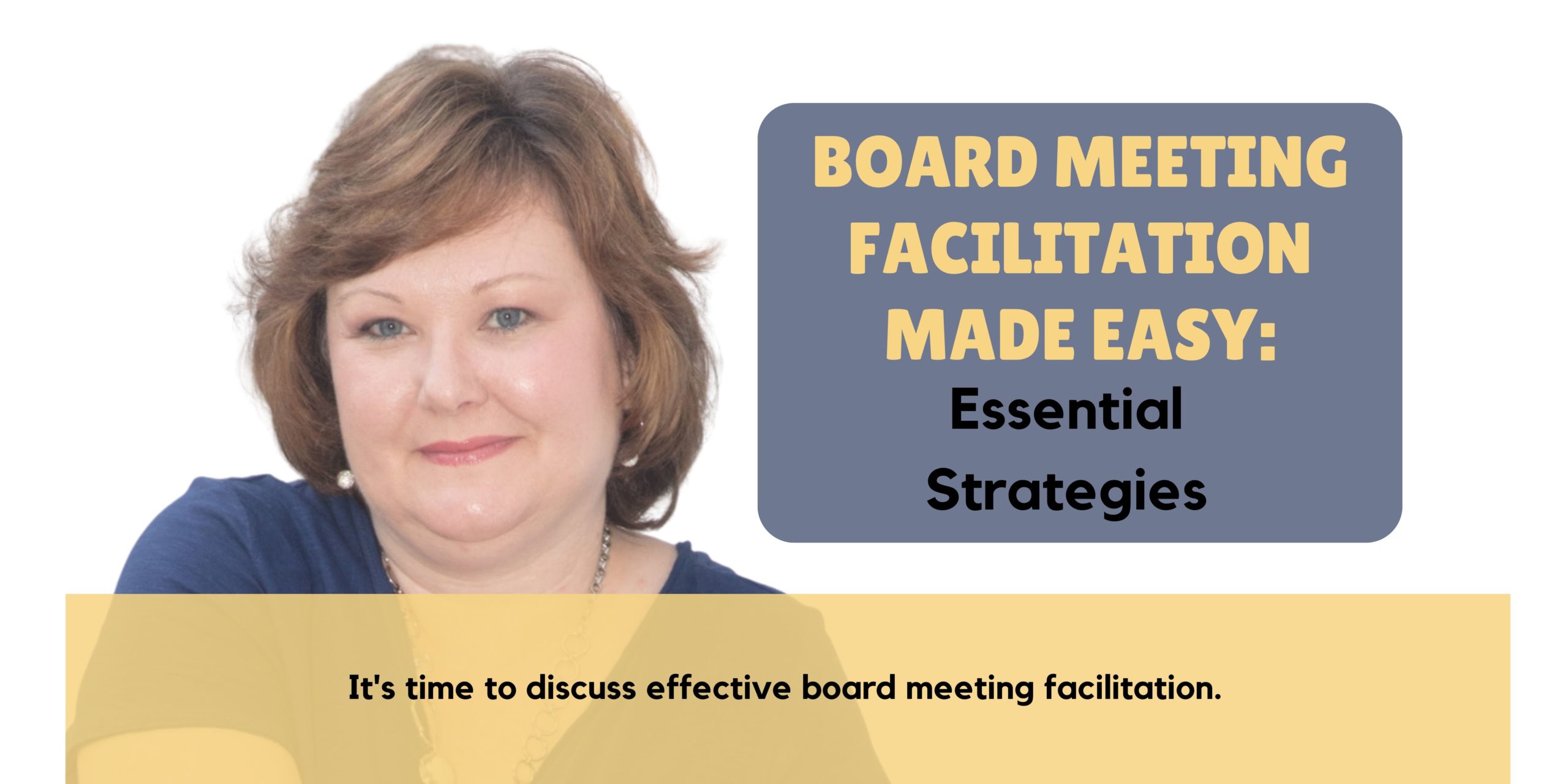Board Meeting Facilitation Made Easy: Essential Strategies
Are you feeling apprehensive about attending another uninteresting and unproductive board meeting?Do you feel your time is wasted and decisions are made without input? It’s time to discuss effective board meeting facilitation if that sounds familiar. An experienced facilitator can make all the difference in ensuring that meetings run smoothly, efficiently, and with everyone’s participation.
This blog post will discuss essential strategies for successful board meeting facilitation. From pre-meeting preparations to mastering the art of online platforms, we will cover everything you need to know for a productive meeting. We will also look at how technology tools can improve facilitation and what roles everyone plays in the meeting. Finally, we will provide tips on how to maintain momentum between meetings and how to use feedback to improve future board meetings. So let’s get started!
Understanding the Importance of Effective Board Meeting Facilitation
Effective board meeting facilitation fosters collaboration and productive decision-making among board members. By ensuring that the meeting stays on track and within the set time frame, a facilitator helps create a collaborative spirit and engages all attendees. Utilizing parliamentary procedure simplifies discussions, decision-making, and sets clear meeting objectives and expectations. A facilitator’s expertise can help keep board meetings purposeful and impactful, benefiting the board of directors.
What is the role of a board meeting facilitator?

In nonprofit board meetings, a facilitator guides the meeting toward its desired outcomes and purpose. They ensure that the discussion remains focused and encourage equal participation from all board members. Additionally, the facilitator manages conflicts and ensures that every board member’s voice is heard respectfully. Maintaining a neutral position, they facilitate dialogue and help board members stay accountable to the board’s goals and bylaws. With their support, nonprofit board meetings can be productive and effective.
What are some common challenges a facilitator may face during a board meeting?
Some common challenges a facilitator may face during a board meeting include dealing with difficult personalities, managing time effectively, ensuring all opinions are heard and respected, keeping the discussion focused and on track, and handling conflicts or disagreements among board members.
Pre-Meeting Preparations for Successful Facilitation
Preparing for a board meeting is crucial for successful facilitation. To ensure a smooth process, develop a comprehensive agenda that covers all relevant topics, allocating sufficient time for each item. Distribute the agenda and supporting materials well in advance, giving board members ample time to review and prepare. Additionally, gather input from board members to address their specific concerns and review previous meeting minutes and committee reports to inform the discussion. Facilitators can create a purposeful and productive meeting environment by taking these steps.
Setting an Effective Agenda

It is important to set a well-structured agenda to ensure an effective board meeting. Prioritize key topics and allocate sufficient time for discussion. Include actionable items, decisions to be made, and time limits for each agenda item to maintain efficiency. Sharing the agenda with board members in advance gives them time to prepare and contribute meaningfully to the meeting. A clear structure and flow help guide the discussion and keep everyone on track.
Establishing Ground Rules
Establishing ground rules is essential to ensure a productive and respectful board meeting. These guidelines set expectations for communication, emphasizing the importance of respect and constructive dialogue. Encouraging active listening and discouraging interruptions helps foster meaningful discussions. Additionally, establishing decision-making guidelines, such as requiring a majority vote, maintains order and ensures fair outcomes. Defining the roles of the board chair and facilitator further contributes to an organized and purposeful meeting. Lastly, highlighting the importance of confidentiality and maintaining the board’s culture creates a safe and trusting environment.
Mastering the Art of Online Meeting Platform

In order to ensure smooth communication during virtual board meetings, choosing a reliable and user-friendly technology platform is essential. Familiarize yourself with the features and functions of the chosen platform to maximize its potential. Conduct audio and video tests before the meeting to address any technical issues. Share meeting materials electronically and make them easily accessible to all participants. Promptly address any technical glitches that may arise to minimize disruptions and keep the meeting running smoothly.
Choosing the Right Technology for Board Meetings
When choosing the right technology for board meetings, it is essential to consider the specific needs and preferences of the board members. Evaluating the technology platform’s security features and data privacy is crucial to protect sensitive information. Additionally, the platform should allow for seamless collaboration and document sharing while being compatible with different devices and operating systems. Seeking feedback from board members on their experience with different platforms can help make an informed decision.
Facilitating Collaboration and Engagement during the Meeting
To ensure active participation from all board members, create a collaborative and inclusive environment during the meeting. Incorporate interactive tools and techniques for brainstorming and idea generation. Encourage board members to share their expertise and perspectives, fostering an atmosphere of engagement. Address conflicts or disagreements constructively to maintain a healthy board culture. Empower each member to contribute meaningfully while keeping the purpose of the meeting in mind.
Time Management Strategies for Board Meetings

Effective time management is crucial for productive board meetings. To ensure efficient use of time, it’s important to set clear start and end times for the meeting and adhere to them. Recent reports show that 17% of people find time limits not being observed as a major meeting issue. Allocate appropriate time for each agenda item based on its importance, use time limits and gentle reminders to keep discussions on track, and prioritize decisions and actions within the meeting timeframe. Encourage efficient note-taking to capture key points without slowing down the discussion.
How can technology tools improve facilitation?
Enhance collaboration and engagement with features like virtual whiteboards and polling. Simplify document sharing and version control for seamless collaboration. Facilitate remote participation, enabling board members to join from anywhere. Video conferencing is a powerful way to unite teams globally—boosting productivity by 94%. Improve communication through chat, private messaging, and video conferencing. Increase efficiency by automating tasks like agenda creation and meeting minutes.
Roles and Responsibilities in Board Meetings
Roles and responsibilities are crucial in board meetings. Board members have the responsibility of decision-making and setting the agenda. Collaboration and productive discussions are essential for effective board meetings. The facilitator plays a key role in keeping the meeting on track and encouraging equal participation. Clear roles and responsibilities ensure efficient use of meeting time. Virtual meetings require effective use of audio and video conferencing tools.
The Role of a Minute-Taker in a Board Meeting

In a board meeting, the minute-taker plays a crucial role in accurately documenting the proceedings. Their good note-taking skills help capture important discussions and action items, serving as a valuable reference for future meetings and accountability. It’s important for the minute-taker to maintain a collaborative spirit and engage with attendees. Following a set time frame for taking and distributing minutes ensures efficiency and keeps everyone on the same page.
Post-Meeting Follow-ups and Feedback
Committee reports update focus areas, keeping the board members informed and engaged between meetings. This maintains momentum and accountability within the board. It is essential to gather specific feedback from board members to identify areas of improvement for future meetings. Utilizing online platforms and collaboration tools such as Zoom or Webex can enhance post-meeting follow-ups, making sharing documents and discussing action items easier. Effective feedback loops ensure continuous improvement of board meetings and help maintain a positive and productive board culture.
Maintaining momentum between meetings: Strategies and Techniques

To maintain momentum between board meetings, it is crucial to set clear goals and objectives that keep board members engaged. Regular communication and updates are essential in maintaining progress and momentum. Leveraging technology and online platforms like Zoom or Webex can facilitate ongoing collaboration and ensure smoother communication. Having a timeframe for follow-up actions helps establish accountability and ensures progress is achieved. Creating a culture of engagement and involvement among board members fosters ongoing momentum and ensures everyone feels heard and valued.
How can specific feedback help improve future board meetings?
Specific feedback plays a crucial role in enhancing future board meetings. It provides actionable insights for improving meeting effectiveness and helps identify areas of improvement. By incorporating feedback, board engagement, and overall meeting experience can be enhanced. Regularly seeking feedback promotes continuous improvement and ensures that the needs of all stakeholders are met.
Conclusion
In conclusion, effective board meeting facilitation is crucial for the success of any organization. The facilitator ensures that meetings are productive, collaborative, and efficient. By setting an effective agenda, establishing ground rules, and utilizing the right technology tools, the facilitator can create an environment that encourages collaboration and engagement among board members. Additionally, post-meeting follow-ups and feedback are essential for maintaining momentum and improving future board meetings. Remember, the success of your board meetings is directly linked to the success of your organization. So, invest time and effort into mastering the strategies and techniques of board meeting facilitation. You can drive positive change and achieve your organization’s goals with the right facilitation skills.
Additional Resources:
Boards Page
Pay-Per-Lesson Create a Board Recruiting and Vetting Process with Bonus What Do You Need at Your Next Board Meeting?

